The DirectX 12 Performance Preview: AMD, NVIDIA, & Star Swarm
by Ryan Smith on February 6, 2015 2:00 PM EST- Posted in
- GPUs
- AMD
- Microsoft
- NVIDIA
- DirectX 12
CPU Scaling
Diving into our look at DirectX 12, let’s start with what is going to be the most critical component for a benchmark like Star Swarm, the CPU scaling.
Because Star Swarm is designed to exploit the threading inefficiencies of DirectX 11, the biggest gains from switching to DirectX 12 on Star Swarm come from removing the CPU bottleneck. Under DirectX 11 the bulk of Star Swarm’s batch submission work happens under a single thread, and as a result the benchmark is effectively bottlenecked by single-threaded performance, unable to scale out with multiple CPU cores. This is one of the issues DirectX 12 sets out to resolve, with the low-level API allowing Oxide to more directly control how work is submitted, and as such better balance it over multiple CPU cores.
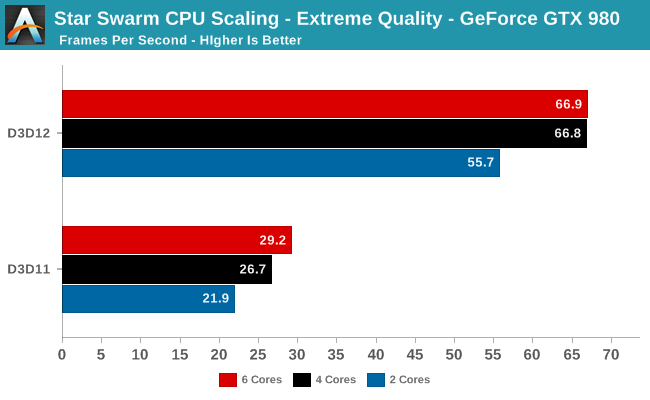
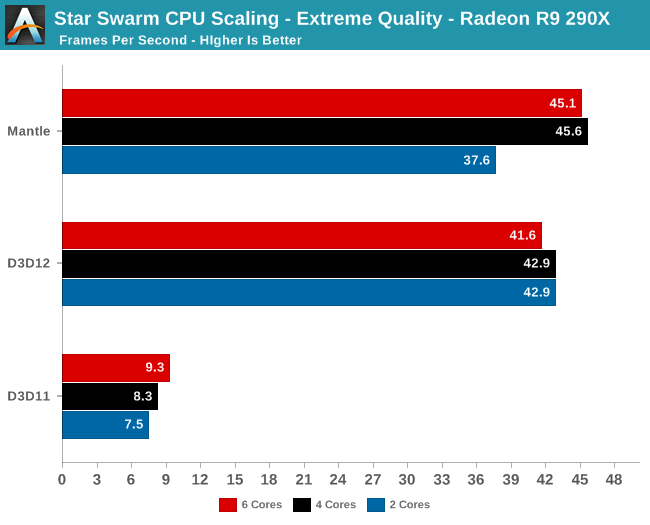
Starting with a look at CPU scaling on our fastest cards, what we find is that besides the absurd performance difference between DirectX 11 and DirectX 12, performance scales roughly as we’d expect among our CPU configurations. Star Swarm's DirectX 11 path, being single-threaded bound, scales very slightly with clockspeed and core count increases. The DirectX 12 path on the other hand scales up moderately well from 2 to 4 cores, but doesn’t scale up beyond that. This is due to the fact that at these settings, even pushing over 100K draw calls, both GPUs are solidly GPU limited. Anything more than 4 cores goes to waste as we’re no longer CPU-bound. Which means that we don’t even need a highly threaded processor to take advantage of DirectX 12’s strengths in this scenario, as even a 4 core processor provides plenty of kick.
Meanwhile this setup also highlights the fact that under DirectX 11, there is a massive difference in performance between AMD and NVIDIA. In both cases we are completely CPU bound, with AMD’s drivers only able to deliver 1/3rd the performance of NVIDIA’s. Given that this is the original Mantle benchmark I’m not sure we should read into the DirectX 11 situation too much since AMD has little incentive to optimize for this game, but there is clearly a massive difference in CPU efficiency under DirectX 11 in this case.
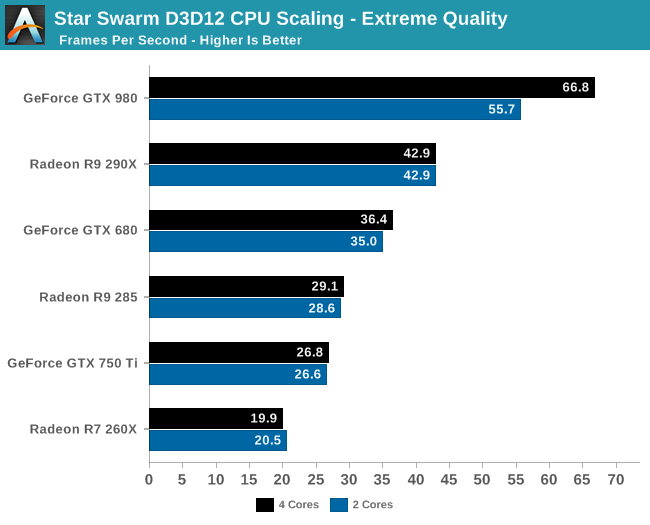
Having effectively ruled out the need for 6 core CPUs for Star Swarm, let’s take a look at a breakdown across all of our cards for performance with 2 and 4 cores. What we find is that Star Swarm and DirectX 12 are so efficient that only our most powerful card, the GTX 980, finds itself CPU-bound with just 2 cores. For the AMD cards and other NVIDIA cards we can get GPU bound with the equivalent of an Intel Core i3 processor, showcasing just how effective DirectX 12’s improved batch submission process can be. In fact it’s so efficient that Oxide is running both batch submission and a complete AI simulation over just 2 cores.
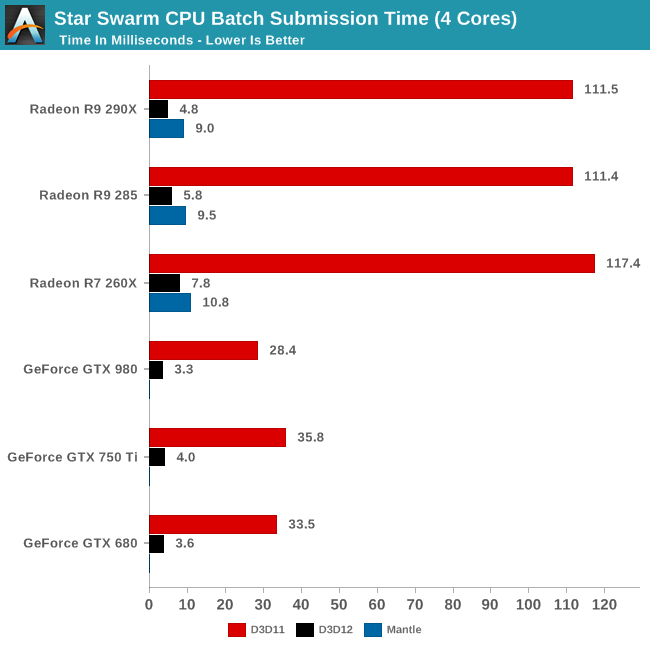
Speaking of batch submission, if we look at Star Swarm’s statistics we can find out just what’s going on with batch submission. The results are nothing short of incredible, particularly in the case of AMD. Batch submission time is down from dozens of milliseconds or more to just 3-5ms for our fastest cards, an improvement just overof a whole order of magnitude. For all practical purposes the need to spend CPU time to submit batches has been eliminated entirely, with upwards of 120K draw calls being submitted in a handful of milliseconds. It is this optimization that is at the core of Star Swarm’s DirectX 12 performance improvements, and going forward it could potentially benefit many other games as well.
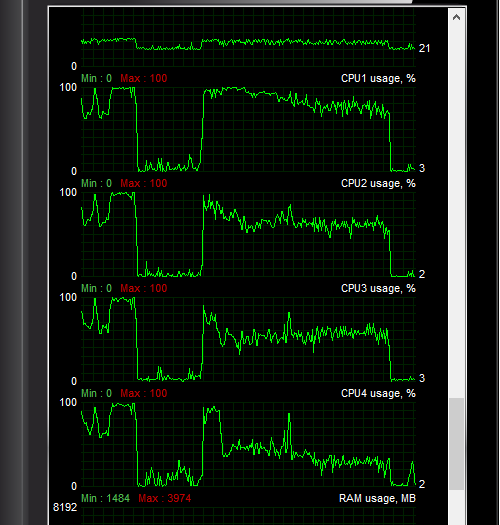
Another metric we can look at is actual CPU usage as reported by the OS, as shown above. In this case CPU usage more or less perfectly matches our earlier expectations: with DirectX 11 both the GTX 980 and R9 290X show very uneven usage with 1-2 cores doing the bulk of the work, whereas with DirectX 12 CPU usage is spread out evenly over all 4 CPU cores.
At the risk of speaking to the point that it’s redundant, what we’re seeing here is exactly why Mantle, DirectX 12, OpenGL Next, and other low-level APIs have been created. With single-threaded performance struggling to increase while GPUs continue to improve by leaps and bounds with each generation, something must be done to allow games to better spread out their rendering & submission workloads over multiple cores. The solution to that problem is to eliminate the abstraction and let the developers do it themselves through APIs like DirectX 12.










245 Comments
View All Comments
Mr Perfect - Sunday, February 8, 2015 - link
That's not what he's saying though, he said TDP is some measure of what amount of heat is 'wasted" heat. As if there's some way to figure out what part of the 165 watts is doing computational work, and what is just turning into heat without doing any computational work. That's not what TDP measures.Also, CPUs and GPUs can routinely go past TDP, so I'm not sure where people keep getting TDP is maximum power draw from. It's seen regularly in the benchmarks here at Anandtech. That's usually one of the goals of the power section of reviews, seeing if the manufacturers TDP calculation of typical power draw holds up in the real world.
Mr Perfect - Sunday, February 8, 2015 - link
Although, now that I think about it, I do remember a time when TDP actually was pretty close to maximum power draw. But then Intel came out with the Netburst architecture and started defining TDP as the typical power used by the part in real world use, since the maximum power draw was so ugly. After a lot of outrage from the other companies, they picked up the same practice so they wouldn't seem to be at a disadvantage in regard to power draw. That was ages ago though, TDP hasn't meant maximum power draw for years.Strunf - Sunday, February 8, 2015 - link
TDP essentially means your GPU can work at that power input for a long time, in the past the CPU/GPU were close to it cause they didn't have throttle, idles and what not technologies. Today they have and they can go past the TDP for "short" period of times, with the help of thermal sensors they can adjust the power as they need without risking of burning down the CPU/GPU.YazX_ - Friday, February 6, 2015 - link
Dude, its total System power consumption not video card only.Morawka - Friday, February 6, 2015 - link
are you sure you not looking at factory overclocked cards? The 980 has a 8 pin and 6 pin connector. You gotta minus the CPU and Motherboard power.Check any reference review on power consumption
http://www.guru3d.com/articles_pages/nvidia_geforc...
Yojimbo - Friday, February 6, 2015 - link
Did you notice the 56% greater performance? The rest of the system is going to be drawing more power to keep up with the greater GPU performance. NVIDIA is getting much greater benefit of having 4 cores than 2, for instance. And who knows, maybe the GPU itself was able to run closer to full load. Also, the benchmark is not deterministic, as mentioned several times in the article. It is the wrong sort of benchmark to be using to compare two different GPUs in power consumption, unless the test is run significantly many times. Finally, you said the R9 290X-powered system consumed 14W more in the DX12 test than the GTX 980-powered system, but the list shows it consumed 24W more. Let's not even compare DX11 power consumption using this benchmark, since NVIDIA's performance is 222% higher.MrPete123 - Friday, February 6, 2015 - link
Win7 will be dominant in businesses for some time, but not gaming PCs where this will be benefit more.Yojimbo - Friday, February 6, 2015 - link
Most likely the main reasons for consumers not upgrading to Windows 10 will be laziness, comfort, and ignorance.Murloc - Saturday, February 7, 2015 - link
people who are CPU bottlenecked are not that kind of people given the amount of money they spend on GPUs.Frenetic Pony - Friday, February 6, 2015 - link
FREE. Ok. FREE. F and then R and then E and then another E.